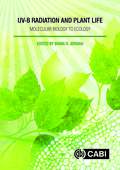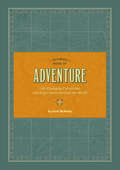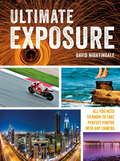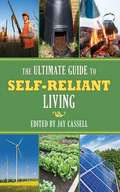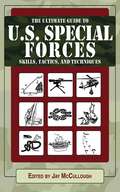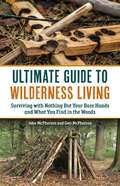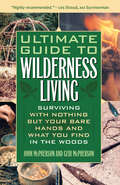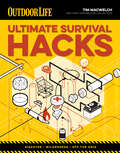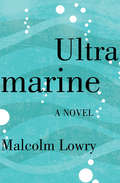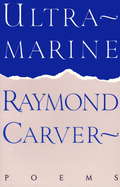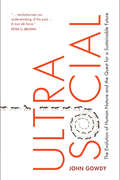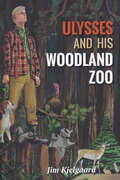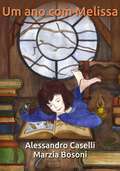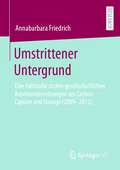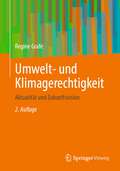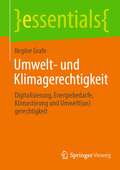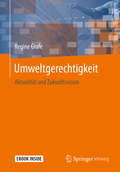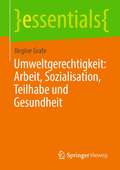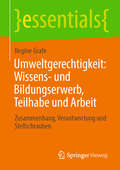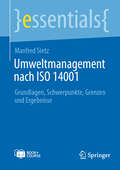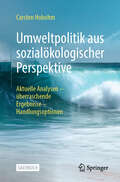- Table View
- List View
UV-B Radiation and Plant Life
by Brian R. JordanUltraviolet-B radiation (UV-B) has profound effects on plant growth and development, and exposure varies with ozone depletion and across geographic regions, with ecosystem and agricultural consequences. This book deals with large-scale impacts but also how UV-B affects plants at the molecular level is also fascinating, and the UV-B photoreceptor has only recently been characterised. While UV-B radiation can be damaging, it also has a more positive role in plant photomorphogenesis. Consequently UV-B treatments are being developed as innovative approaches to improve horticulture. This book is a timely synthesis of what we know and need to know about UV-B radiation and plants.
Ultimate Book of Adventure: Life-Changing Excursions and Experiences Around the World
by Scott McNeelyBreak out of your comfort zone and find a new adventure in this guide to some of the world’s most amazing experiences.From tracking gorillas in Uganda to cliff diving in Brazil, surfing a volcano in Nicaragua, or starting a tomato fight in Spain, this action-packed guide is bursting with inspiring ideas for trying the unfamiliar, taking risks, or pursuing a new experience. Containing in-depth descriptions and logistical information for each activity, this handbook also features survival skill tips and an adventure kickstart guide. Ranging from death-defying stunts to easy and safe family vacations, Ultimate Book of Adventure has an escapade for everyone and welcomes travel junkies and armchair travelers along for the ride.
Ultimate Exposure: All You Need to Know to Take Perfect Photos with any Camera
by David NightingaleExposure is photography's fundamental concept. Master it, and you'll master photography.You don't need a book to take good photos any more; most (but not all) of the time your camera, or your phone, will handle things for you. But if you don't know what it's doing - you don't know how to expose photos - you can't join in the real fun of photography.With this book, though, you'll quickly master the key principles, and grasp a few simple concepts that will open up a world of beautiful sunsets, clever silhouettes, light trails and bokeh - as well as sophisticated techniques like HDR, manual exposure blending, and focus stacking.Armed with this knowledge the digital photos you share will stand head-and-shoulders above the rest, and you'll have no problem using that film camera or used Polaroid you picked up at that garage-sale.
Ultimate Guide to Self-Reliant Living, The
by Jay CassellBeing a homesteader today may seem difficult; the world is full of so many gadgets and conveniences, many of which most of us consider necessary to live a full and happy life. In this collection, edited and arranged by Jay Cassell, you'll see that going off the grid, adapting to your surroundings, and depending on yourself and your land is really not as challenging as one may think. With the information and tips you learn in this book, you'll easily find success as a modern-day homesteader.The essays featured in The Ultimate Guide to Self-Reliant Living were written by some of today's most respected outdoorsmen and outdoorswomen, nature enthusiasts, agricultural professionals, and successful homesteaders. Through the information on these pages, you will learn the best techniques and approaches concerning:Hunting, fishing, and trappingForagingGrowing and preparing your own foodAnimal husbandryLiving off the gridBuilding barns and outbuildingsGreen livingCountry skillsAlternative energy, such as solar panels and windmillsPrimitive survival skills, such as making fires and finding shelter
Ultimate Guide to U.S. Special Forces Skills, Tactics, and Techniques (Ultimate Guides)
by Jay McculloughEveryone knows that members of the U.S. Special Forces are the top-shelf, crème de la crème, A-Number-Ones, specially hand-picked people to train and serve as the avant garde of the largest, most well-funded military on the face of the earth. But that doesn't happen overnight! There are special training procedures--over and above basic training--that turn a swabbie into a SEAL, a grunt into a Green Beret, or a runt into a Ranger. Collected here for the first time is official information on USSF: Sniper training Reconnaissance Intelligence and interrogation Guerrilla warfare Nocturnal operations Fighting counter insurgencies And more! With hundreds of photographs and illustrations demonstrating proven tips and techniques, The Ultimate Guide to Special Forces Skills, Tactics, and Techniques provides everything a warrior needs to know to be fighter-ready and strong.
Ultimate Guide to Wilderness Living: Surviving with Nothing But Your Bare Hands and What You Find in the Woods
by John McPherson Geri McPhersonSurvivalists of all levels can use Ultimate Guide to Wilderness Living to learn primitive living skills, tools for optimal self-sufficiency, and how to better be prepared for any and all adventures into the wild!Packed with in-depth instruction and photos, this guidebook teaches the skills needed to survive and live in the wild using only those things found in the woods or in other natural landscapes. Learn how to ignite a fire with a two-stick hand drill, erect temporary and semi-permanent structures, and more with wilderness experts John and Geri McPherson. &“During my first years of learning survival I took a course in survival and primitive earth skills taught by John and Geri McPherson. I was excited by their unbelievable passion and their intrinsic understanding of survival. Their teachings took me from understanding basic skills to a full-blown love for the ancient technologies that humans developed to survive. John and Geri are the real deal. They don&’t just teach this stuff, they live it. I loved the experience with them so much I came back a second time a few years later. Now that I have traveled the world as Survivorman—experiencing and filming survival in every ecosystem there is—I can sit back and watch my shows and see John and Geri&’s teachings peek through in every situation. I have been able to understand survival because of John and Geri, and can highly recommend this book.&” —Les Stroud, AKA Survivorman
Ultimate Guide to Wilderness Living: Surviving with Nothing But Your Bare Hands and What You Find in the Woods
by John Mcpherson Geri McphersonEVERYTHING THERE IS TO KNOW ABOUT SURVIVING IN THE WILD"During my first years of learning survival I took a course in survival and primitive earth skills taught by John and Geri McPherson. I was excited by their unbelievable passion and their intrinsic understanding of survival. Their teachings took me from understanding basic skills to a full-blown love for the ancient technologies that humans developed to survive. John and Geri are the real deal. They don't just teach this stuff, they live it. I loved the experience with them so much I came back a second time a few years later. Now that I have traveled the world as Survivorman-experiencing and filming survival in every ecosystem there is-I can sit back and watch my shows and see John and Geri's teachings peek through in every situation. I have been able to understand survival because of John and Geri, and can highly recommend this book." --Les Stroud, AKA SurvivormanPacked with in-depth instruction and photos, Ultimate Guide to Wilderness Living teaches you the skills need to survive and live in the wild using only those things found in the woods. Learn how to: Ignite a fire with a two-stick hand drill Erect temporary and semi-permanent
Ultimate Survival Hacks (Outdoor Life)
by Tim MacWelchThe New York Times bestselling author of Prepare for Anything shares 500+ tricks for surviving any emergency with everyday items.Fortune favors the prepared—and knowing how to innovate, improvise, and make do with the hundreds of survival hacks covered in this guide will prepare you for just about anything. Detailed advice and step-by-step illustrations show you how to handle natural disasters, wilderness mishaps, and total catastrophes with whatever you have to hand, from duct tape to plastic bags to acorns.Survival expert Tim MacWelch covers situations ranging from the common to the once in a lifetime (you hope!). In this book, you’ll learn how to use junk food to start a campfire, harvest drinkable water from morning dew, use your belt to sharpen a knife, suture a wound with dental floss, use a bra as a respirator, and much, much more. If you can find it in an emergency, Tim can almost certainly help you turn it into a survival tool!
Ultramarine: A Novel (Modern Classics Ser.)
by Malcolm LowryFrom the author of Under the Volcano: A novel of a young man&’s flight from the upper class to join the hard-living crew of a freighter bound for South Asia. In this debut novel by the acclaimed novelist and poet, Dana Hilliot seeks absolution from his wealthy British upbringing, escaping the bourgeois provincialism of his origins by setting out to sea as a messboy amid a crew of weathered, world-weary sailors. Lost somewhere between Singapore and Bombay, Hilliot has fled his oppressive life—and his first love—for a world that has no interest in his problems. Part Moby Dick, part A Portrait of the Artist as a Young Man, Ultramarine draws on Malcolm Lowry&’s own early experience—and displays the flair for character and dazzling prose that distinguished him as one of English literature&’s greatest modern talents.
Ultramarine: Poems (Vintage Contemporaries)
by Raymond CarverOne of Raymond Carver&’s final collections of poetry, moving from the beauty of the natural world to thoughts of mortality and family and art. Throughout, Carver &“has the astonished, chastened voice of a person who has survived a wreck, as surprised that he had a life before it as that he has one afterward, willing to remember both sides&” (The New York Times Book Review).
Ultrasocial: The Evolution of Human Nature and the Quest for a Sustainable Future
by John M. GowdyUltrasocial argues that rather than environmental destruction and extreme inequality being due to human nature, they are the result of the adoption of agriculture by our ancestors. Human economy has become an ultrasocial superorganism (similar to an ant or termite colony), with the requirements of superorganism taking precedence over the individuals within it. Human society is now an autonomous, highly integrated network of technologies, institutions, and belief systems dedicated to the expansion of economic production. Recognizing this allows a radically new interpretation of free market and neoliberal ideology which - far from advocating personal freedom - leads to sacrificing the well-being of individuals for the benefit of the global market. Ultrasocial is a fascinating exploration of what this means for the future direction of the humanity: can we forge a better, more egalitarian, and sustainable future by changing this socio-economic - and ultimately destructive - path? Gowdy explores how this might be achieved.
Ulysses and His Woodland Zoo
by Jim Kjelgaard"Nature has been called “the effect whose cause is God.” Ulysses became an integral part of this effect and, in spite of the fact that he considered himself the world’s top bumbler—often with plenty of reason, vehemently vouched for by those left behind in the debris—he proved himself indispensable to the Woodland Work into which he characteristically stumbled. In the world of man, Ulysses blundered constantly, but in the world of the forest, where he surprisingly became winter caretaker and lone occupant of an isolated hunters’ lodge, he attained dignity wisdom and assurance as he employed every faculty of his senses and opened his heart to its mysteries and its beauty—and its animal residents. For Ulysses was not alone for long. During that winter in his beloved woods he acquired his amazing wild zoo. This included a pugilistic crippled antelope buck, an injured bird, a lost beagle, a rabbit saved from a weasel and a baleful bobcat! He also acquired a dangerous human enemy. All were a challenge to his young manhood—met with simple courage and unique glory. Ulysses and His Woodland Zoo is a true example of Jim Kjelgaard’s buoyant, sensitive writing.
Um Ano com Melissa
by Alessandro Caselli Marzia BosoniSeis contos para crianças que tratam de ecologia e de respeito Respeito pelo meio ambiente, pelos animais e por nós mesmos: eis do que tratam os diálogos entre Melissa, uma menina de seis anos com muita vontade de entender o mundo, e o Senhor Gato, um esperto gato de rua. Seis histórias para contar um ano da vida da menina e para compartilhar um pouco da sabedoria que o gato conquistou pelas ruas do mundo. Entre uma história e outra, o gato se dirige aos pais, e aos adultos em geral, para pedir também a eles para parar um momento e refletir sobre temas importantes como a ecologia, a poluição, a dor e a amizade. Um livro para crianças, mas também um livro para adultos que ainda sabem encontrar tempo para falar com os pequenos. E com os Gatos.
Umbrella (Picture Puffin Ser.)
by Taro YashimaMomo can't wait to use the red boots and umbrella she received on her birthday. All she needs now is a rainy day! Soft illustrations portray a thoughtful story about patience and growing independence.
Umstrittener Untergrund: Eine Fallstudie zu den gesellschaftlichen Auseinandersetzungen um Carbon Capture and Storage (2009-2012)
by Annabarbara FriedrichDie Autorin analysiert die gesellschaftlichen Auseinandersetzungen um den frühen Implementierungsversuch einer Carbon Dioxide Removal Technologie. Diese Maßnahmen sind vom Weltklimarat als ein Baustein zur Eindämmung des Klimawandels anerkannt. Die EU setzte eine solche Technologie, Carbon Capture and Storage (CCS), bereits im Jahr 2009 auf die politische Agenda der Mitgliedstaaten. Die Arbeit untersucht die restriktive Regulierung der Kohlendioxidabscheidung und –speicherung in Deutschland, die im journalistisch-öffentlichen Diskurs auch als gescheitert dargestellt wird. Statt die (fehlende) öffentliche Akzeptanz von CCS zu erklären, untersucht die Arbeit die gesellschaftliche Politisierung des Technologie-Sets. Auf der Grundlage von Theorieansätzen der Science and Technology Studies werden die Deutungsrahmen von Interessengruppen auf Bundesebene analysiert. Die Inhaltsanalyse, der öffentlichen Dokumente von Gesellschaftsakteuren im Kontext des Gesetzgebungsverfahrens (2009-2012), zeigt die Verknüpfung von Carbon Capture and Storage und bestehenden soziotechnischen Systemen sowie deren gesellschaftspolitische Kontexte. Die qualitative Analyse behandelt ein vergangenes Beispiel einer umstrittenen technologischen Intervention. Dies ist zugleich zukunftsweisend, da nachträgliche Methoden der CO2-Entnahme aktuell im Zusammenhang von sog. unvermeidbaren Restemissionen erneut diskutiert werden.
Umwelt- und Klimagerechtigkeit: Aktualität und Zukunftsvision
by Regine GrafeEs wird die Komplexität von Umweltverschmutzung und Gesundheitsbeeinträchtigung im Kontext von sozialer Indikation dargestellt. Mit Hilfe von Sozialindikatoren wird aufgezeigt, wie Umweltverschmutzung, Gesundheitszustand, Bildungsteilhabe und Arbeitswelt auf die Menschen, insbesondere in Ballungsgebieten und in ausgewählten Innenstadtbereichen sowie in Satelitenstädten unmittelbar zusammenhängen. Die Bewertungsgrößen Predicted Mean Vote (PMV) und Physiological Equivalent Temperature (PET) werden im Kontext der Humanbiometereologie (HBM) ausführlich diskutiert Stadtklimatologie und Geometrie der Stadtarchitektur werden in Hinblick auf die urbane Gesundheit und die soziale Beeinflussungen der Bewohner dargestellt.
Umwelt- und Klimagerechtigkeit: Digitalisierung, Energiebedarfe, Klimastörung und Umwelt(un)gerechtigkeit (essentials)
by Regine GrafeDer Zusammenhang von Umweltzerstörung und Klimastörung infolge der sich rasant entwickelnden Digitalisierung in allen Lebensbereichen der Menschen wird kritisch hinterfragt. Der Energiebedarf für die aktuell weltweit genutzten digitalen Endgeräte bewegt sich derzeit im Terra-Watt-Bereich. Diese Energiemenge wird noch immer mehrheitlich aus fossilen Energiequellen gewonnen, gefolgt von biologischen Quellen wie Mais, Raps, Getreide, Palmen und weitere. Der sich rasant entwickelnde Plattformkapitalismus der GAFA-Monopole und weiteren hat zu einem Anstieg des Energiebedarfs für digitale Endgeräte gesorgt. Die Folgen sind eine vermehrte Freisetzung von Treibhausgasen und vor allem von Abwärme, die einen nicht unmaßgeblichen Anteil der Störung der Wärmebalance und damit der Klimastörung hat. Digitalisierung bewirkt darüber hinaus auch gesellschaftliche Veränderungen wie neue Arbeitsmodelle und Arbeitszeitmodelle und erfordert neue, nämlich digitale, Kompetenzen. Der damit verbundene Einschnitt in die gesellschaftlichen Strukturen zeigt sich bereits in einer steigenden Vereinzelung der Menschen, die mit Identitätsverlust, Verhäuslichung und Desozialisation einhergeht.
Umwelt- und Ökologiebewegungen: Ein Überblick (essentials)
by Jens Boscheinen Laurens BortfeldtEin junges Mädchen aus Schweden schafft, was viele über Jahrzehnte versucht haben. Greta Thunberg und die Fridays for Future-Bewegung schlagen Alarm und die Politik hört nicht nur zu, sondern ist angesichts der Kraft der sozialen Bewegung dazu gezwungen, aktiv zu handeln. Das vorliegende essential betrachtet die Umweltbewegungen in Deutschland der vergangenen 50 Jahre, gibt Einblicke in die Denkweise der Fridays for Future-Bewegung und ordnet diese ein.
Umweltgerechtigkeit – Wohnen und Energie: Instrumente und Handlungsansätze (essentials)
by Regine GrafeWie sozial gerecht ist Wohnraum? Sollen Mieter, die in nicht gut gedämmten Wohnungen leben, dafür zahlen, dass sie aufgrund dessen mehr Energie verbrauchen und höhere Energiekosten haben? Müssen externalisierte Kosten der Energiegewinnung und -verteilung nicht zukünftig internalisiert werden? Der ganzheitliche Umweltgerechtigkeitsansatz impliziert auch Gesundheitsgerechtigkeit. Das heißt, sowohl sozialräumliche Gegebenheiten als auch soziökonomische Belange sind im Zusammenhang mit der Energieeffizienz von Wohngebäuden und der Energieversorgung einzubeziehen. Die Problematiken, die sich daraus ergeben, sind nicht mit den aktuell üblichen Transferleistungen für Einkommensschwache zu lösen. Erforderlich sind stadtplanerische Instrumente gepaart mit politischem Willen, wie energieeffiziente Sanierung von Wohnbauten und Stadtquartieren, Vermeidung von Raumreduktion und den damit verbundenen siedlungshygienischen und stadtklimatischen Beeinflussungen der Gesundheit der Bewohner. Notwendig ist auch das Einbinden von wegeökonomischen Mobilitätskonzepten in den Bestand der Verkehrswege.
Umweltgerechtigkeit: Aktualität und Zukunftsvision (Essentials Ser.)
by Regine GrafeEs wird die Komplexität von Umweltverschmutzung und Gesundheitsbeeinträchtigung im Kontext von sozialer Indikation dargestellt. Mit Hilfe von Sozialindikatoren wird aufgezeigt, wie Umweltverschmutzung, Gesundheitszustand, Bildungsteilhabe und Arbeitswelt auf die Menschen, insbesondere in Ballungsgebieten und in ausgewählten Innenstadtbereichen sowie in Satelitenstädten unmittelbar zusammenhängen. Die Bewertungsgrößen Predicted Mean Vote (PMV) und Physiological Equivalent Temperature (PET) werden im Kontext der Humanbiometereologie (HBM) ausführlich diskutiert Stadtklimatologie und Geometrie der Stadtarchitektur werden in Hinblick auf die urbane Gesundheit und die soziale Beeinflussungen der Bewohner dargestellt.
Umweltgerechtigkeit: Arbeit, Sozialisation, Teilhabe und Gesundheit (essentials)
by Regine GrafeUnter Einbindung des Umweltgerechtigkeitsansatzes, der die Gesundheitsgerechtigkeit impliziert, werden Fragen zur Bedeutung von non-formaler und formaler Bildung im Kontext der Sozialisation des Einzelnen in einer sich verändernden Gesellschaft gestellt. Wieviel und vor allem welche Art von Teilhabe ermöglicht die Gesellschaft aktuell und vor welchen Herausforderungen steht sie in Zukunft? Welche zukunftsfähigen Bildungsinhalte müssen vermittelt werden für die sich aktuell rasant verändernde Gesellschaft? Es bedarf nicht nur neuer Wissens- und Kompetenzvermittlung, sondern auch eines Paradigmenwechsels beim Arbeitsschutz. Was bedeutet das für die Gesellschaft und den Einzelnen? Es geht dabei auch um Assimilation, Integration und Onboarding. Wer wird die notwendigen Bildungsinhalte zukünftig vermitteln und mit welchem Anspruch? Welche Rolle wird die Arbeits(um)welt dabei spielen? Fragen, die aktuell gestellt werden müssen, um gesellschaftspolitische Antworten darauf zu finden.
Umweltgerechtigkeit: Zusammenhang, Verantwortung und Stellschrauben (essentials)
by Regine GrafeAusgehend vom Konzept des „Sozialen Raumes“, der im ganzheitlichen Begriff der Umwelt verankert ist, stellen sich Fragen nach dem Einfluss sozialer Räume auf den Menschen. Welchen Einfluss haben Lern- und Arbeitsumwelt? Wie ist es mit Chancengleichheit des Einzelnen und seiner Teilhabe bestellt? Wie hängen Wissen und Bildung zusammen? Nicht jeder, der viel weiß, ist auch gebildet. Welche Bedeutung hat die antizipatorische Bildung in der Familie und welche der Arbeits-, Lern- und Lebensumwelt? Fragen, die zweifelsohne mit sozioökonomischen Bedingungen eng zusammenhängen. Aber ist das ausschließlich darauf zu reduzieren? Wie wird die Zukunft der Arbeitswelt als Wissenswelt und damit deren Einfluss auf den Einzelnen aussehen? Welche Kompetenzen werden erforderlich sein für diese neue Arbeitswelt und wer wird sie vermitteln? Welche Bildungsinhalte werden deren soziale Räume vermitteln und mit welchem Ziel? Wenn Wissen zur Ware wird und damit beliebig, wer übernimmt dann die Verantwortung für dessen Vergegenständlichung als Produkt?
Umweltmanagement nach ISO 14001: Grundlagen, Schwerpunkte, Grenzen und Ergebnisse (essentials)
by Manfred SietzUmweltmanagement eines Unternehmens bedeutet, die Umweltauswirkungen minimierend zu managen, um die Qualität unserer Umwelt zu erhalten oder zu verbessern. Managen bedeutet in der Originalübersetzung etwas zu verwalten. Also eine Aufgabe mit Verantwortung, Zielen und Aktivitäten. Alle diese Managementtools werden zuzusammengefasst in der weltweit gültigen und zertifizierbaren Norm ISO 14001.
Umweltpolitik aus sozialökologischer Perspektive: Aktuelle Analysen - überraschende Ergebnisse - Handlungsoptionen
by Carsten HobohmAngesichts einer zunehmend bedrohlichen Kulisse stellt sich die Frage, wie der Klimawandel, die Intensivierung der Nutzung von Ökosystemen und die Bedrohung der Artenvielfalt das soziale und kulturelle Leben beeinflussen. In den Medien haben Katastrophenmeldungen zweifellos zugenommen. Doch in welcher Weise das gesellschaftliche Leben oder die Menschheit insgesamt durch Umweltkatastrophen konkret bedroht ist, wird bislang nur selten in ausreichender Detailschärfe dargestellt. Mit dieser Analyse wird versucht, den Knoten der gelegentlich einseitigen Betrachtung zu lösen und den Blickwinkel um einige Möglichkeiten der Ausgestaltung von Zukunft zu erweitern. Eine ganze Palette von Möglichkeiten zielt darauf ab, den Fokus der global dunklen, gleichzeitig unscharfen oder sogar verschwommenen Perspektiven um positive Ansätze in der lokalen und regionalen Dimension zu erweitern. Möglichkeiten sind reichlich vorhanden, aber sie sind nicht zum Nulltarif zu realisieren.
Umweltrecht: Ein Lehrbuch (Umweltwissenschaften Ser.)
by Ulrich Smeddinck Rainer Wolf Winfried Kluth Guy Beaucamp Susanna Much Rüdiger Nolte Hans-Jürgen Sack Anne-Barbara WalterDieses Lehrbuch bietet eine Einführung in das Umweltrecht insbesondere auch für Praktiker und Nicht-Juristen. Ausgehend von den allgemeinen Grundlagen werden die wichtigsten Bereiche des Umweltrechts vorgestellt. Als wichtige übergreifende Materie ist das Klimaschutzrecht berücksichtigt. Zu Steigerung des Gebrauchswertes in der Praxis wird ein besonderer Akzent auf die Themen Rechtsschutz und das Umweltstrafrecht gesetzt.
